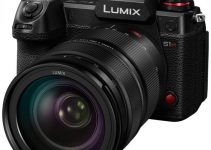We have definitely entered the time of greater than 4K resolutions. Everything from mirrorless cameras to traditional cinema cameras now come standard with incredible options, no doubt a result of faster media and powerful computers becoming widely available. Many of these options will even find their way into the hands of everyday filmmakers and photographers.
Working the the team at Epic Light Media, filmmaker Armando Ferreira has gotten three extremely popular >4K cameras to test: the 6K-shooting Canon EOS C500 Mark II, 8K-capable Canon EOS R5, and the mind-boggling URSA Mini Pro 12K. The test will help show off the differences between the cameras as well as determine whether or not all those extra pixels are worth the hassle.
Starting off with simply how the tests were done, Ferreira had to address the fact that while both Canon cameras use full-frame sensors, the URSA Mini features a Super 35mm one.
This meant that they did have to move the full-frame models closer to the subject to match framing. This is so that they could use the same exact lens on every camera – the Canon CN-E 50mm T1.3 L F Cine Lens.
Beyond physical setup, the cameras all matched settings as best as they could. All were using the same white balance, aperture, etc. They also made sure to use raw when they could with the big decision being the use of 12:1 compression for the Blackmagic RAW settings which Epic Light Media tested and found to be very good.
Another consideration is that Epic Light Media is very familiar with Blackmagic workflows and they handled all the coloring for the 12K footage. That included knowing some deep technical background via conversations with Blackmagic on how to best edit, including noise reduction. The Canon cameras, however, just received a standard Rec.709 LUT and then minor corrections to match with the URSA.
Time for the tests! The YouTube video was created in the 8K sequence. This meant the 66K C500 was upscaled and the 12K URSA was downscaled. It also means you’ll want to be watching on at least a 4K display and make sure you are in 4K resolution.
The first test was between the C500 and URSA in a very controlled lighting environment. Ferreira claims that the footage looks very similar on their 8K timeline. That may be true at 100% zoom, but once they do the punch in it is very apparent that the URSA 12K is much sharper. Arguably, the C500 could come a lot closer with a little sharpening.
Next was a test with a more natural outdoors setting and some artificial lighting. Moving the aperture down to T2.8 revealed some differences between the camera. The URSA seems to have a problem with moire.
Also, the C500 benefitted hugely from the extra sharpness of the lens at this setting. I think the C500 might be the better camera here and that Blackmagic has some work to do to make that 12K resolution stand out. But keep in mind the URSA is actually the more affordable camera.
Moving to the R5 against the URSA we have a more even battle between resolutions. The R5’s 8K raw is very, very good. Ferreira even claims that the URSA doesn’t have as good of highlight roll off as the R5 does.
Also, the URSA seems to add a bit of yellow in their model’s hair. The R5 looks a bit more natural. On the other hand, the R5 isn’t perfect and has a green fringe around the model’s earrings.
Putting the cameras on a level playing field, they recording with the URSA at 8K to match the R5. Surprisingly, the 8K from the R5 appeared to be a bit sharper than the URSA, likely due to less-than-ideal downsampling methods from Blackmagic.
Moving both cameras to 4K, with the R5 being in its 4K HQ mode, the Canon absolutely wins. Being a true downsample from 8K helps it a ton.
Now for a note on the URSA’s blockiness at 4K resolution. Going back to how they decided to shoot in 12:1 compression based on early tests. For 12K this is a great option.
However, when you start choosing 4K you get blockiness at high compression ratios. Epic Light Media found that you need to choose 5:1 compression or better to eliminate this issue. Blackmagic is apparently looking into this issue and will hopefully be preparing a fix.
Epic Light Media took their own chance to give an opinion on the URSA 12K. They definitely love the camera, the look, and the detail of 12K footage. However, the moire is an issue and there isn’t yet an OLPF filter available for the 12K.
The higher-res sensor also seems to show off a lot more noise at all settings. Considering the amazing 4.6K model is already available that is likely the more reasonable option for a lot less money.
They also said that they couldn’t pick a clear winner when considering all the factors. That alone should prove that higher resolutions isn’t everything.
Unfortunately, the Canon RAW Light format isn’t enjoyable to edit with while Blackmagic RAW was buttery smooth. Canon might be delivering amazing cameras, but considering the cost difference with the 12K and the fact that the 4.6K is available for much less the 12K just might not be what most people need.
I think I have to agree with that. I think that the price points for all the cameras situate them quite well for the market. The Canon C500 Mark II is looking to be the best overall for a premium price.
Blackmagic is making amazing cameras at affordable prices with the URSA line. And, the R5 is kind of a weird camera for hybrid shooters and might not be the best for pro video applications.
What were your thoughts after watching?
[source: Armando Ferreira]
Order Links:
- Blackmagic Design URSA Mini Pro 12K Cinema Camera (B&H, Amazon)
- Canon EOS R5 Mirrorless Camera (B&H, Amazon)
- Canon EOS C500 Mark II Cinema Camera (B&H)
- Canon CN-E 50mm T1.3 L F Cine Lens (B&H)
Disclaimer: As an Amazon Associate partner and participant in B&H and Adorama Affiliate programmes, we earn a small comission from each purchase made through the affiliate links listed above at no additional cost to you.



